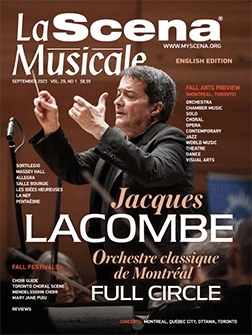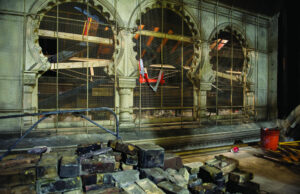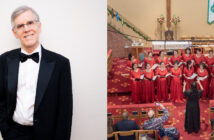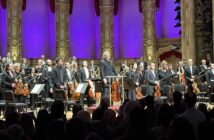
This page is also available in / Cette page est également disponible en:
![]() Francais (French)
Francais (French)
The pressure was on for the Corporation of Massey Hall and Roy Thomson Hall when, in 2018, they announced they were closing Canada’s oldest and most well-respected concert hall for a major renovation and restoration project that would span 18 to 24 months. Following almost three years of construction (the project was delayed by the COVID-19 pandemic), the hall reopened in November 2021, and has been back in action ever since.
Massey Hall was opened in 1894. For almost 100 years, it was the home of both the Toronto Symphony Orchestra and the Toronto Mendelssohn Choir. Countless musical stars have graced the hall’s stage, among them classical singers Luciano Pavarotti, Maria Callas, and Maureen Forrester; composers Glenn Gould (who made his Massey Hall debut at just 13 years old) and Edward Elgar; and jazzers Charlie Parker, Oscar Peterson, Dizzy Gillespie, and Charles Mingus. An important venue for popular and folk music, it has also seen performances by the likes of Gordon Lightfoot, who performed at Massey Hall on several occasions, Neil Young, and the rock band Rush, among countless others.

In 1981, it was named a National Historic Site, at which point the building was already “not up to modern standards,” as Grant Troop, the corporation’s vice-president of operations, puts it. The challenges were many: the building was without a loading bay, making it difficult to get instruments and equipment into the hall; decorative elements such as its iconic moldings and balconies were aging and deteriorating; emergency systems were out of date; there was a lack of hospitality spaces (bathrooms, bars, lounges), and accessibility was a major concern, says Troop. The question senior leadership was faced with in 2018 was fairly simple: either they would be forced to close the facility entirely, or they had to do something substantial to address these issues.
It was decided that the corporation would embark on a large-scale renovation and heritage restoration project, which required a “big vision.” The project’s motto was to “improve everything, but change nothing,” says Troop, adding: “We wanted audience members to recognize (the hall), to feel the same intimacy and Victorian grandeur that they were used to.”
The project was never going to be easy. While Massey Hall had endured, the renovation process revealed “lots of mysteries” about its construction. With only “30 ink drawings on linen, from 1894” to work from, architects and engineers had to problem-solve as they went, resulting in “lots of pivoting and changing direction.” In many cases, these pivots required the assistance of experts on historical buildings, local artisans, and specialty tradespeople, brought in alongside the teams from KPMB Architects and EllisDon construction. “We brought in specialists in restoration, to work with the hall’s traditional and historical materials, and stabilize the balconies, for example,” says Troop. “The goal was to preserve the environment, in ways that were almost imperceptible.”


Maintaining the integrity of the space mattered to the Corporation of Massey Hall and Roy Thomson Hall because it mattered to audiences and musicians. “Canada’s Carnegie Hall” has made a name for itself on account of its legacy, and the intimate musical setting it provides concertgoers and performers alike: keeping this intact was crucial to the project’s success. The renovations thus aimed to maintain the acoustics for audiences, while improving the acoustic experience of performers.
In 2021, the hall reopened with a special concert by Gordon Lightfoot. True to their word, the renovations are significant, but do not interfere with the space’s ambience. Within the main hall, changes have been made to the balconies, the stained glass windows have been restored and made visible from inside the hall, and the seating has been reconfigured such that floor seats can be removed to accommodate a standing audience for popular music concerts. Outside the hall, though, is where one finds the most substantial changes.
Arguably the most significant elements of the renovations have been the construction of the all-new Allied Music Centre. Consisting of a nine-storey tower behind the heritage building, the Allied Music Centre is attached to Massey Hall by a series of passerelles, and contains the load-in bay, bars, lounges, bathrooms, and elevators. Troop remarks that the new build was “needed to address the safety, load-in, accessibility, and economic concerns” that precipitated the project. The new space contains two of Massey Hall’s now four performance spaces: the TD Music Hall, with a capacity of 500; and a smaller, unnamed theatre on the sixth floor, with a capacity of 100 to 150 people, ideal for smaller performances of acoustic or chamber music. These two spaces, the main hall, and its attached “post-concert basement venue,” which accommodates 300, leave Massey Hall ready for performances of all genres and scales. This is part of the facility’s mission; “We are all about flexibility (and) supporting the next generation of Canadian artists,” Troop says.
While many expressed concern in 2018 at news of the renovation project, the audience response since the hall’s reopening has been resoundingly positive. Following a successful 2022-23 season, Massey Hall looks forward to hosting a wide variety of events, including the Polaris Music Prize Gala (Sept. 19), De Yun She (Sept. 30), Bonnie Raitt (Oct. 6), the Women’s Blues Revue (Nov. 17), Choir! Choir! Choir! (Nov. 25), and Jeremy Dutcher (Dec. 9), among many more, this fall.
This page is also available in / Cette page est également disponible en:
![]() Francais (French)
Francais (French)















